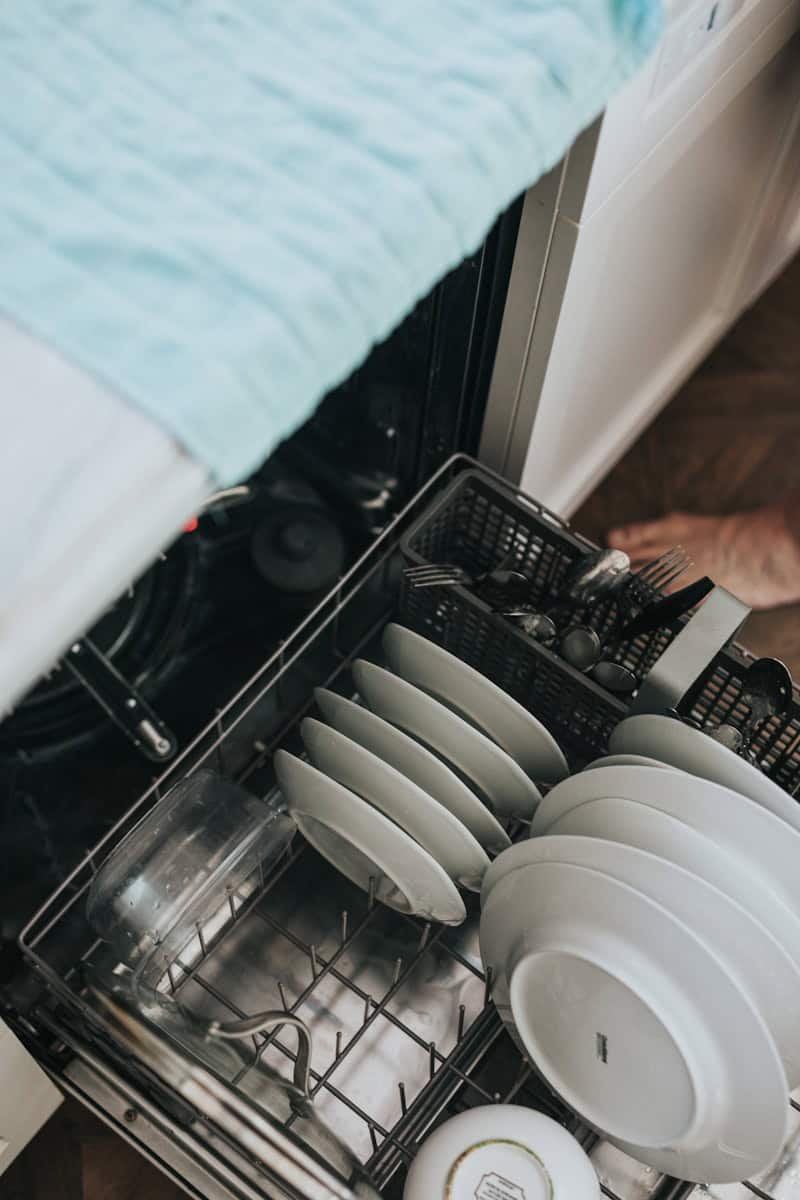A dishwasher that leaves dishes dirty is a major frustration. But before you call a repair technician, there are several common culprits you can investigate yourself. Here’s a breakdown of why your dishwasher might not be cleaning dishes effectively on the top or bottom rack, and how to troubleshoot the issue.
Reasons Why Dishwasher Isn’t Cleaning Dishes on Top or Bottom Rack Well
1. Spray Arm Problems
The spray arms are responsible for showering dishes with water and detergent. If they’re blocked or damaged, cleaning performance will suffer.
- Clogs: Food particles, especially small seeds or pieces of broken dishes, can clog the spray arm holes.
- Solution: Remove the spray arms (consult your user manual) and clear any blockages with a toothpick or thin wire.
- Obstructions: Large items, like pots or pans, can block the spray arm’s rotation.
- Solution: Ensure items are loaded properly and not interfering with the spray arms’ movement.
- Damage: Cracks or breaks in the spray arm can affect water pressure and distribution.
- Solution: Inspect the spray arms for damage and replace if necessary.
2. Water Supply Issues
Insufficient water pressure or temperature can hinder the dishwasher’s cleaning ability.
- Low Water Pressure: The dishwasher needs adequate water pressure to function correctly.
- Solution: Check your home’s water pressure and ensure the water supply valve to the dishwasher is fully open.
- Low Water Temperature: Hot water is essential for dissolving detergent and sanitizing dishes.
- Solution: Make sure your water heater is set to at least 120°F (49°C). Run the hot water tap in your sink before starting the dishwasher to ensure hot water is reaching the appliance.
3. Detergent and Rinse Aid Problems
Using the wrong detergent or not enough rinse aid can affect cleaning performance.
- Incorrect Detergent: Use only dishwasher-specific detergent. Using regular dish soap can create excessive suds and hinder cleaning.
- Solution: Switch to a quality dishwasher detergent.
- Insufficient Rinse Aid: Rinse aid helps prevent water spots and improves drying.
- Solution: Make sure the rinse aid dispenser is full.
4. Loading Issues
Overloading or improperly loading the dishwasher can prevent dishes from getting clean.
- Overloading: Cramming too many dishes into the dishwasher restricts water and detergent circulation.
- Solution: Load the dishwasher according to your user manual’s recommendations.
- Improper Loading: Incorrectly placing dishes can block spray arms or prevent proper cleaning.
- Solution: Ensure dishes are facing the center of the dishwasher and not nesting or obstructing each other.
5. Filter Clogs
The dishwasher filter traps food particles to prevent them from recirculating. A clogged filter can reduce cleaning efficiency.
- Solution: Locate the filter (usually at the bottom of the dishwasher) and remove it. Rinse it thoroughly under running water to remove any debris.
6. Dishwasher Pump or Motor Issues
If you’ve ruled out other causes, a faulty pump or motor could be the issue. These problems usually require professional repair.
- Solution: Contact a qualified appliance repair technician to diagnose and fix the problem.
| Problem | Solution |
|---|---|
| Clogged spray arms | Remove and clean spray arms |
| Blocked spray arms | Load dishes properly to avoid obstruction |
| Low water pressure | Check water pressure and supply valve |
| Low water temperature | Increase water heater temperature |
| Incorrect detergent | Use dishwasher-specific detergent |
| Insufficient rinse aid | Fill rinse aid dispenser |
| Overloaded dishwasher | Load dishes according to recommendations |
| Improper loading | Ensure dishes face the center and don’t obstruct each other |
| Clogged filter | Remove and clean the filter |
| Pump or motor issues | Contact a repair technician |
5 Key Problems Affecting Dishwasher Performance
Blocked Water Jets
Clogged spray arms can significantly impact a dishwasher’s cleaning ability. These arms, located at the bottom and sometimes under the top rack, distribute water throughout the appliance. When blocked, they may not rotate freely or spray water effectively.
Signs of blockage:
- Reduced water pressure
- Uneven cleaning across racks
- Visible debris in spray arm holes
To check for clogs:
- Remove the lower rack
- Inspect spray arm holes
- Clear any visible obstructions
- Test arm rotation manually
Malfunctioning Detergent Release
A properly functioning soap dispenser is crucial for effective cleaning. Most modern dishwashers have a locking tray inside the door panel. This tray should open during the wash cycle to release detergent.
Problems arise when:
- The dispenser fails to open
- Detergent becomes caked inside
- The locking mechanism breaks
These issues can lead to dishes coming out dirty or with soap residue. Regular inspection and cleaning of the dispenser can prevent many of these problems.
Interior Buildup and Contamination
Over time, dishwashers can accumulate:
- Food particles
- Grease
- Soap scum
- Hard water deposits
This buildup affects cleaning performance and can contaminate dishes during wash cycles. A dirty dishwasher interior may produce unpleasant odors, resembling vinegar at the end of a cycle.
Maintenance tips:
- Run empty cycles with vinegar monthly
- Wipe down interior surfaces regularly
- Check and clean filters as needed
Faulty Water Inlet Valve
The water inlet valve controls water flow into the dishwasher. When this component fails, it can lead to insufficient water for proper cleaning.
Symptoms of a failing inlet valve:
- Low water levels during cycles
- Weak water pressure
- Leaks from the sides or bottom
- Incomplete cleaning cycles
Diagnosing this issue often requires professional assessment. Homeowners should check for visible leaks and listen for unusual noises during the fill cycle.
Inadequate Water Temperature
Dishwashers require hot water to clean effectively. The ideal temperature is around 120°F (49°C). Lower temperatures may leave food particles and grease on dishes.
To check water temperature:
- Run hot water at the kitchen sink until it’s hot
- Use a thermometer to measure the water temperature
- If below 120°F, adjust the water heater settings
Low water temperature can result in:
- Greasy residue on dishes
- Food particles remaining after cycles
- Lack of steam when opening mid-cycle
Regular maintenance and prompt attention to these issues can significantly improve dishwasher performance. Users should consult their appliance manual for specific troubleshooting steps and maintenance schedules.
Top 5 Fixes for a Malfunctioning Dishwasher
1. Clear Blocked Spray Arms
Dishwashers often collect food particles in their spray arms. These clogs prevent water from reaching dishes effectively. To address this:
- Remove the spray arms
- Inspect the holes for blockages
- Use a toothpick to remove debris
- Rinse arms under running water
- Reattach securely
For stubborn clogs, soak arms in vinegar solution for 30 minutes before cleaning.
2. Address Detergent Dispenser Issues
A faulty soap dispenser can hinder cleaning performance. Check these points:
- Door opens smoothly
- Spring mechanism functions correctly
- No soap residue around edges
If issues persist, consider replacing the dispenser unit. Consult the dishwasher manual for correct part numbers and installation instructions.
3. Deep Clean Interior Surfaces
Regular interior cleaning prevents residue buildup. Follow these steps:
- Remove racks and filters
- Wipe down walls and bottom with damp cloth
- Use dishwasher cleaner for tough stains
- Clean door gasket to ensure proper seal
- Replace filters and racks
For hard water areas, run an empty cycle with vinegar monthly to prevent mineral deposits.
4. Replace Faulty Inlet Valve
A defective inlet valve can cause inadequate water flow. To replace:
- Turn off water supply
- Disconnect power
- Locate valve (usually behind lower front panel)
- Remove old valve
- Install new valve, matching model number
- Reconnect water and power
- Test for leaks
Always use plumber’s tape on connections to prevent future leaks.
5. Verify Water Supply Connections
Incorrect water connections lead to poor cleaning results. Check these points:
- Hot water line connected to dishwasher
- Water temperature reaches 120°F (49°C)
- Supply hoses free of kinks or damage
- Water pressure adequate (20-120 psi)
If temperature is too low, adjust water heater settings. For persistent issues, consult a plumber to assess home water supply.
Additional Tips:
- Use rinse aid to improve drying and prevent spots
- Load dishes properly, avoiding overcrowding
- Scrape large food particles before loading
- Run hot water at sink before starting dishwasher
- Consider using a water softener for hard water areas
By following these steps, most dishwasher cleaning issues can be resolved without professional help. Regular maintenance and proper use will extend the appliance’s lifespan and ensure consistently clean dishes.







